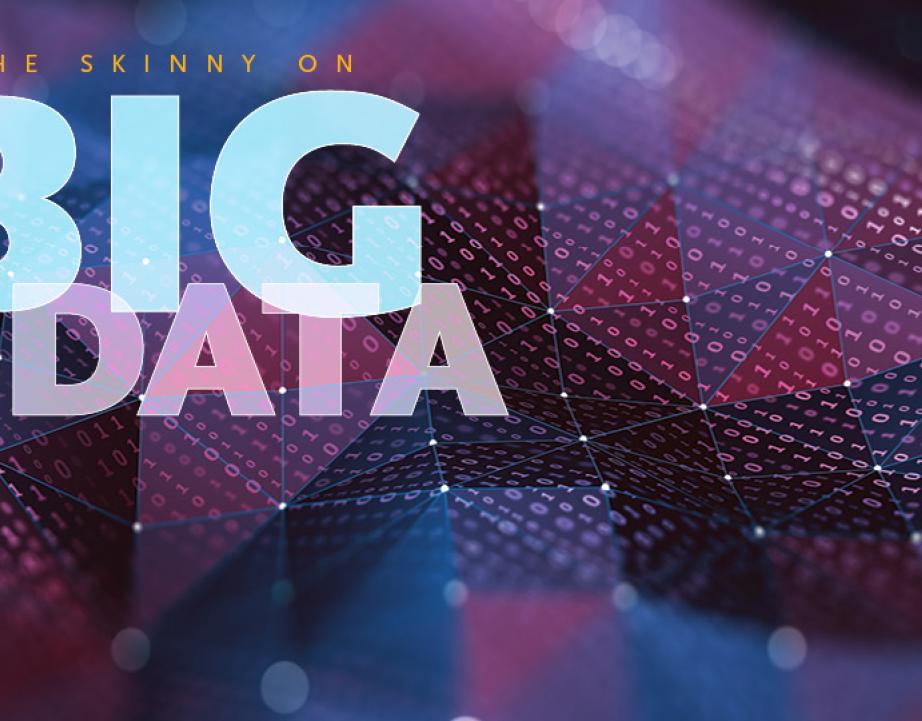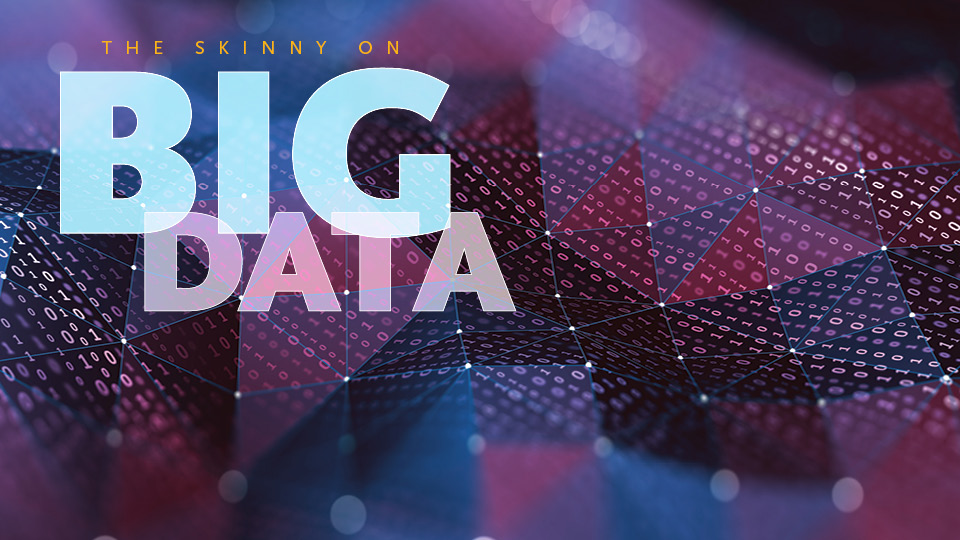by Adam Grybowski
Sweigart Hall opened this fall after a complete, months-long renovation. Among the upgraded classrooms and expanded lobby, the building’s new Business Data and Analytics Lab stood out as a visible symbol of the University’s commitment to training students to harness the power of Big Data, one of the hottest fields in business.
Last year, Rider’s College of Business Administration launched a new undergraduate program in business analytics, and in the spring, it hosted the 2018 American Statistical Association DataFest competition, a 48-hour event in which teams of up to five students work to reveal insights from a large and rich data set.
For this issue of Rider magazine, the business faculty leading these efforts, along with alumni working in the field, contributed their insights into helping you understand why Big Data is so important right now, and where it might be heading in the future.
Ethics and privacy
For more than two decades, people around the globe have enjoyed, at little or no cost, an array of internet-based applications. That business model has paid off handsomely for companies because it generates data that is often more valuable than subscription fees. While it is certainly not unfair for providers to profit from their investments and innovations, such a model comes with significant costs to the user. We pay in terms of time and responsibility. We must know and understand how providers use the data we generate, and we must maintain preferences to protect our privacy and security. Many people are unwilling or unable to carry out these responsibilities. Is there a role for government to regulate providers of online services in the same ways, say, that media companies are regulated? This is a question we, as a society, will decide in the coming years. An effective decision will establish sensible boundaries that strike a balance between promoting growth and innovation and preventing abuse. Achieving that balance will be a huge challenge.
-Dr. William Amadio, Associate professor of information systems and the director of Rider’s Center for Business Analytics
Cybersecurity
Organizations across the world are falling victim to data breaches engineered by hackers, costing them millions in compliance and regulatory penalties and considerable damage to their reputations. No matter the cost, at the end of the day security breaches are going to happen. What separates how businesses fare is how well-prepared they are in identifying and responding to attacks. Some organizations use software like the one developed by my company, Curricula, to send out simulated phishing attacks (those bogus emails that trick victims into opening emails and clicking links that expose their personal information) against their employees to demonstrate what a real-world attack would look like. This exercise allows organizations to receive eye-opening feedback on how their employees would perform against such an attack. They can use this information to improve processes and procedures to guide them to act appropriately. Incident response exercises are a powerful way to understand the risks of an attack. No organization should ever want its first taste of a data breach to be experienced during the real thing.
Nick Santora ‘08, ‘11, CEO of Curricula, a cybersecurity training and phishing simulation company headquartered in Atlanta, Ga.
Health care
The health care industry generates massive amounts of data, and the ability to analyze this data is vital to health care organizations. Hospitals and health systems are focused on achieving the “quadruple aim” — reducing per capita costs, improving both the patient and provider experience, and creating healthier patients by focusing on population health. At the foundation of successful population health management strategies is health data analytics, a broad term that has many variations but at its core refers to the analysis of data to explore and identify trends and patterns in patient-related data. Health data analysts use their knowledge to manage, analyze, interpret and “transform” data into actionable information. Understanding the patterns and correlations discovered in health care data is used to make better-informed health care decisions, and these types of analyses create benefits that reverberate across the entire health care ecosystem — patients, providers, employers, insurance companies, the pharmaceutical industry and health care policy.
Dr. Kristin McCarthy, Visiting assistant professor of health care management
Artificial intelligence
The next technology that will have a major impact on Big Data is artificial intelligence. Over the past 10 years or so, we have seen the proliferation of data warehouses that allow organizations to store massive troves of organizational knowledge, which is used to help make critical business decisions. Artificial intelligence platforms that provide cognitive computing capabilities like natural language processing and machine learning will bring businesses to the next level of decision making and customer service. One of the most popular use cases for cognitive computing is to emulate a human expert that can answer questions on a particular domain of knowledge. This is possible because these technologies are designed to mimic the functions of the human brain. IBM Watson, Microsoft Cognitive Services, Google AI Cloud and others are all in competition to be the first AI platform to radically change the way businesses leverage Big Data in their everyday operations. It will be exciting to see which one emerges as the leader in this space.
Sean R. Piotrowski ‘04, ‘07, Adjunct lecturer and manager, Cloud Services at iCIM
Innovation and disruption
For years we have seen evidence of Big Data driving innovation in the form of manufacturing improvements, supply chain efficiencies, and customized products and services. Big Data can also reveal opportunities to create something so new and novel that it can cause major disruptions in the way things are traditionally done. Think about how you listen to music today. You may be old enough to remember buying vinyl or CDs, or maybe you used to buy and download music onto a device like an iPod. Now, Big Data aids in the creation of personalized music streams through data mining and analytics software that uncovers patterns, trends and relationships in data in minutes or even seconds. Such previously unavailable insights can also yield insight into large-scale problems and opportunities in just about every industry. As the variety of integrated data sources — social media, videos, emails, text messages, images and sensor data from a growing number of internet-connected devices (also known as the Internet of Things) — grows, and the types and the speed of processing power expand, we will continue to see innovation in the form of original ideas transformed into new products and services.
Dr. Lauren Eder, Professor of information systems
Storage
The average high definition movie takes up about four gigabytes of data. Working as a storage engineer, I’ve helped companies like Comcast and Facebook manage roughly 120 petabytes of information, which is equal to 120 million gigabytes — or 300,000 high definition movies! If large companies needed to buy enterprise storage servers to house all the data they manage onsite, they’d go bankrupt from the cost. Instead, many buy open source servers that are much cheaper. But open source servers have another advantage as well; they level the playing field for small companies by putting them in control of their own data and destiny, giving them the ability to grow their storage and computing footprint as needed. This allows a two-person startup to compete with bigger rivals. However, relying on such a method to store data creates a lot of risk because it concentrates data in only a few places, making the servers a very enticing target for hackers.
Chris Holcombe ‘05, Lead storage engineer, Comcast
Creating a competitive business advantage
While the term “Big Data” seems to be very popular nowadays among scientists and practitioners alike, research shows that the capabilities to extract actionable business insights from Big Data are not so common among today’s organizations. Those who possess such capabilities are both more productive and more profitable than their unequipped counterparts. Some of my current research focuses on how technology, particularly data visualization and analytics tools, can aid business analysts in making sense of otherwise incomprehensibly large and complicated datasets. The ability to use these tools effectively is currently in very high demand from employers seeking data analysts who can help generate competitive advantage from Big Data, which is one reason I’m very excited about the launch of Rider’s new business analytics program and the privilege I have of teaching our students about cutting-edge analytics tools and techniques in our state-of-the-art facilities.
Dr. Emre Yetgin, Assistant professor of information systems


